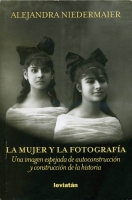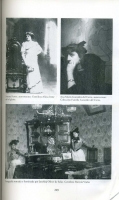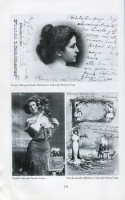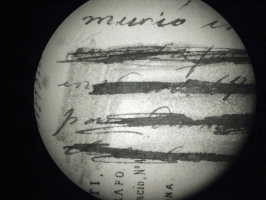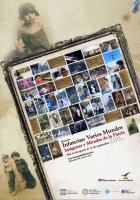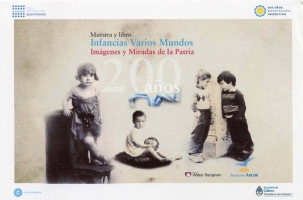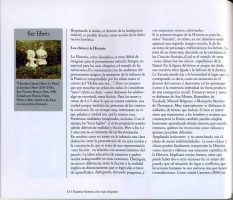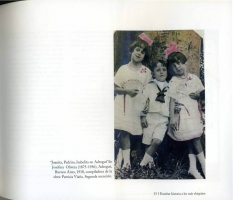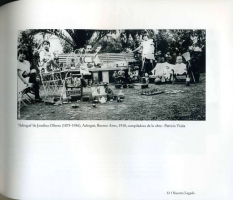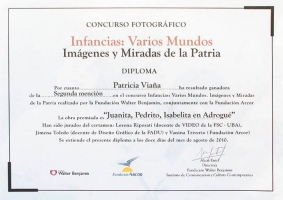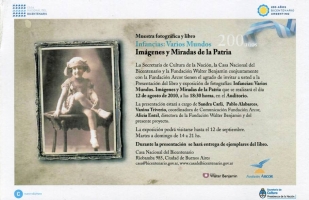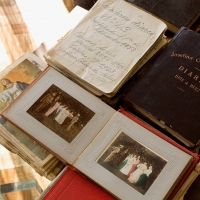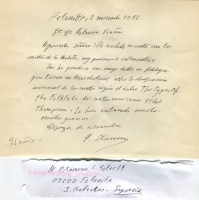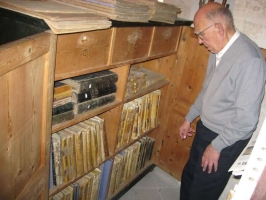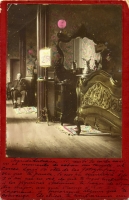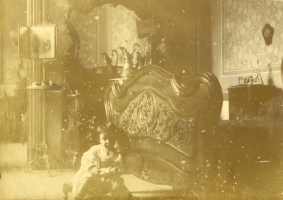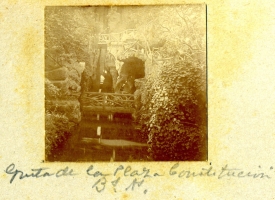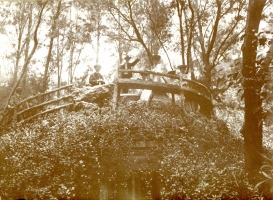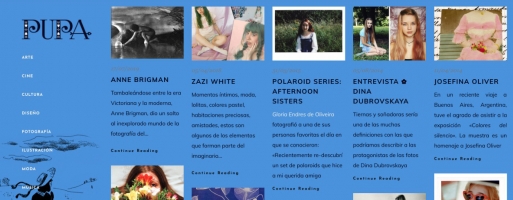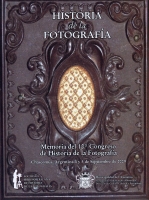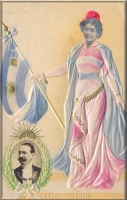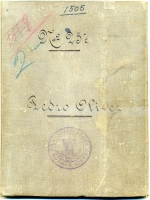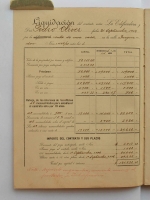JOSEFINA OLIVER'S OEUVRE, DISCOVERY AND INVESTIGATION
by Patricia Viaña
In October 2006, Isabel Balaguer de Politzer, Josefina Oliver’s, granddaughter, lent me the third volume of her grandmother’s Diary.
When opening it, I was surprised at many of the photos taken by Josefina, which were inserted among the written pages of the diary. Thanks to this I could finally recognize the author of the photos I had found at home, which had belonged to my maternal grandmother, Catalina Oliver, Josefina’s dearest younger sister.
In the face of over 150 images, I thought I was in front of a 19th century photographer and, to confirm it, I decided to look for more material within my family.
Thanks to Josefina´s grandchildren, Isabel and Pepita Balaguer, and the Salas Oliver, I got the 20 volumes of the Diary with 8400 pages; and about 2500 photos between albums, collages and loose ones. In the homes of my cousins Jorge, Mecha and Inés Toyos and my brother Julián Viaña, I collected the rest of her photo albums, postcards and collages that we had inherited from our grandmother Catalina.
This way I gathered the vast number and variety of Josefina Oliver’s scattered material that, because of being fragmented, kept hidden and unnoticed from 1892 to 2006.
Once this collection was consolidated, Josefina Oliver revealed her originality and her creative coherence. Thus, it imposed upon me the presentation of her oeuvre for considering it a public good.
From the very beginning of my work, I sought for the help of researchers and professionals to analyze the artistic disciplines she worked on and, through them, show her time and context. Since that moment, Josefina Oliver was supported by:
Florencia Blanco, professional photographer, who saw her as an important photo amateur and illuminator (colourist) of her own copies.
Abel Alexander, investigator and photography historian, surveyed part of Josefina´s work and characterised her as a pioneer and a vanguardist in Argentina. He also invited Patricia Viaña to deliver a lecture at the 10th Congress of the Ibero-American Society of History and Photography.
He also connected her with Alejandra Niedermaier, photographer and teacher, who was at that time writing a book about the first 100 years of photography made by women in Latin America.
Niedermaier incorporated Josefina Oliver in her book La mujer y la fotografía. Una imagen espejada de autoconstrucción y construcción de la historia (Women and photography, a mirrored image of selfconstruction and construction of history) (Buenos Aires, Ed. Leviatán, 2008).
The following year, 2007, Patricia Viaña created the Archivo Josefina Oliver (Josefina Oliver Archive) to organise her works collected through the past months.
Ángeles Cornejo, specialist in Visual Arts and animated films, started digitalising all Josefina Oliver´s recently received material and used part of it into the realisation of a video: Fotos y postales de: Josefina Oliver- Pepa Papa Pepita ( Josefina Oliver’s Photos and Postcards – Pepa Papa Pepita ).
Together with Viaña, they collected information about the different schools Josefina had attended between 1881 and 1888. They also carried out a pitiful search with no positive results about Josefina’s mother’s medical record, Juana Rebasa de Oliver, at the Moyano Hospital where she died in 1894.
Florencia Sapir, a sociology student, continued the digitalizing work at the JO Archive during 2008.
Inés Ulanovsky, photographer and coordinator at the Archivo Abuelas de Plaza de Mayo (Abuelas de Plaza de Mayo Archive), inspected and approved the structure and development of the JO Archive. She suggested accompanying Josefina Oliver’s work with Patricia Viaña’s investigations and conclusions.
Patricia Viaña showed Josefina Oliver´s work to Alejandro Castellanos, Director of the Centre of the Image in Mexico City, at the 15th Festival de la Luz Portfolios Review in Buenos Aires. He defined her work as “a complete corpus, a very important archive for Latin American Photography”.
He also indicated Viaña to contact Patricia Gola, co-founder of the photographic magazine Luna Córnea from Mexico City, for assessment on the JO Archive management and its presentation to the public.
Gola, as Ulanovsky before, suggested adding a photo caption to Josefina Oliver´s work together with Patricia Viaña´s complementary investigations about the author.
In 2009 Viaña asked Stella Pértile de Poggi, from the Association of Public Calligraphers from the City of Buenos Aires, to try to read behind a number of crossing-outs in some photos and pages from Josefina´s personal Diary. Her conclusion, after different tests, was that the ink used contained iron and made it impossible to read the texts.
In August, Patricia Viaña presented the lecture Josefina Oliver, escritora y fotógrafa inédita del Buenos Aires de fin del siglo XIX (Josefina Oliver, unknown writer and photographer from Buenos Aires at the end of the century) in Florencia Blanco's photography workshop. Inés Tanoira and Jorge Marino, students with no specialization in antique photography, wrote very interesting papers about it.
The same lecture was presented in September at the 10th Congress of the Iberoamerican Society of History and Photography, in Chascomús, Buenos Aires.
The following month, Viaña travelled to Udine, Italy, to collect more material from Josefina’s granddaughter; to Mallorca and Barcelona, Spain, looking for both family and public historical sources.
In December Carolina Ciacciulli, archive specialist, started working at the JO Archive. She introduced Patricia Viaña to Silvia Gattafoni, librarian at the Instituto Nacional de Antropología y Pensamiento Latinoamericano (National Institute of Anthropology and Latin American Thought) (INAPL), who revised the JO Archive.
In 2010, Gattafoni directed the creation of the JO Archive’s documentary background, in which she organized the material collected over the last four years into a logical structure.
Through her advice, the INAPL offered the guardianship of Josefina Oliver’s original complete oeuvre. Although this offering was very appreciated by the family, they finally decided to keep the property over it.
In August, thanks to her grandniece Cristina García Oliver, Josefina Oliver participated in the contest “Infancias: Varios Mundos. Imágenes y Miradas de la Patria” (“Infancies: Several worlds: Images and Sights upon the Mother Country”). Patricia Viaña presented 5 photos taken by Josefina Oliver which got 3 mentions.
The contest was organised and promoted by the Walter Benjamin and Arcor Foundations and its exhibition was held at Casa del Bicentenario, Buenos Aires. The awarded photos were included in a book with the same name of the contest, co-edited by Alicia Entel (Director of the Walter Benjamin Foundation) and the Arcor Foundation.
Patricia Viaña long investigated about corvette La Constancia, a ship that was always referred to according to her family oral tradition. Due to this investigation she got to contact Fabián Montojo, creator of the blog Alta Mar.
This generous scholar from Palma de Mallorca, found records of the ship from 1853 at the Spanish Virtual Library of Historical Press. He instructed Viaña in the use of this virtual tool and included one of her writings about Josefina Oliver and the ship in his blog.
‘Fabián wants me to explain how I found, in 2010, La Constancia Corvette made in a shipyard in Mallorca in 1851. I can only say with great enthusiasm and passion for sailing the oceans to come.
This ship was a ghost in the mist of my family oral history. Almost without listening, I had vaguely heard my mother and my aunt saying that her grandfather Pedro Juan Oliver y Colomar had arrived in Buenos Aires in 1870 from Palma de Mallorca on that ship; her great grandfather Pedro Juan Oliver y Mas had been one of its captains. They also added to these inaccuracies the question whether the name was Constanza or Constancia.’
Luis Príamo, photography researcher and historian, advised Viaña, out of his vast experience, for a future edition of a book about Josefina Oliver.
Mario Sánchez Proaño, a specialist in digital conservation, supervised the digitalisation of the Josefina Oliver Archive.
Patricia Viaña met Bernat Oliver, a Majorcan historian who helped her find an oil painting of La Corbeta Constancia, which had been sold in 2003 at Christie’s auction.
With all the material collected over the last four years, Patricia Viaña joined Josefina’s descendants and oeuvre together at the house of Isabel Balaguer de Pollitzer. For the first time, they were able to see the complete Collection of the Diary in twenty volumes, eight photo albums, postcards, loose photographs and the Libro de curiosidades (Book of Curiosities) with collages.
Inés Tanoira, professional photographer, took pictures of the family enjoying that moment:
The Father Pere Xamena, priest and historian from the isle of Mallorca, Spain, collaborated with Josefina Oliver´s research with genealogical and historical data about the Oliver family.
He also offered the text “Cuentos de abuelita” (“Grannie’s Tales”) from Josefina´s diary to a scholar.
Felanitx, November 2nd, 2012
Mrs. Patricia Viaña
Appreciated Madam: I have received your letter with ‘Grannie’s Tales’, very funny and interesting.
I have shared them with a doctor in philology who holds his doctoral thesis about the universal classification of tales according to The Types of the Folktale by the American Stith Thompson. He is really interested in them.
Thank you very much.
Always at your service, P. Xamena
María José Mulet, Tenured Professor of Theory of the Arts, Balearic Islands University, Spain, and curator of Photographic Archives in Palma de Mallorca, encouraged Viaña to publish Josefina Oliver’s work and suggested her to contact
María de los Santos García Felguera, Tenured Professor of Art History and Photography at Pompeu Fabra University, Barcelona, Spain, who generously offered Patricia Viaña her tutoring for a thesis about Josefina Oliver.
Carolina Ciacciulli contacted Alba Obrutsky, a researcher at the Atomic Energy Commission, CONEA, to see part of the crossing-outs in texts and photos through infrared or ultraviolet rays. Once again the iron ink made it impossible to read the texts.
In May 2011, Liliana Parra, photographer and teacher, worked with Josefina Oliver´s photos in her Intervened Photography workshop at Museo de Arte y Memoria in La Plata, province of Buenos Aires.
That same year, after seeing the JO Archive, the filmmaker Darío Schvarzstein considered Josefina Oliver´s work for a possible documentary.
In December, Inés Tanoira and Patricia Viaña, began the photographic edition for a future exhibition about Josefina Oliver.
In 2012, Eduardo Molinari, visual artist and college professor, joined the team to work on the project for the exhibition about Josefina Oliver. He suggested the interrelation of her four creative areas: the writing in her personal diary, the photography, the photo illuminations (colouring) and the collages. Together, Tanoira, Viaña and Molinari achieved the realisation of the structure of the Exhibition Josefina Oliver. Colores del Silencio (Josefina Oliver. Colours of Silence).
Guadalupe Gaona and Ignacio Masllorens, started writing a script for a documentary, Fotografía en Argentina del 1900 (Photography in the Argentina of 1900), based on the life and work of Josefina Oliver, Christofredo Jakob and Clemente Onelli.
The playwrighter Bea Odoriz included photographs from the JO Archive in her play De tropos, noes y perros, performed at the Hasta Trilce theatre in September.
Valeria González, graduated in Art History. UBACYT photography researcher and Abel Alexander assessed and gave their appraisal on the exhibition Josefina Oliver. Colores del Silencio (Josefina Oliver. Colours of Silence).
Martin Schoo started working at the JO Archive researching and doing English translations.
In 2013, Silvia Gabarrot designed the graphic presentation of the exhibition. Inés Tanoira devised its photographic edition.
They both introduced Franco Verdoia, advertisement, drama and film director, to Viaña. He filmed the documentary Josefina Oliver y su obra: Diarios, Fotos y Collages about Josefina Oliver.
Also in 2013, Liliana Parra wrote “Diarios iluminados” (“Illuminated diaries”), a text where she elaborates the idea of Josefina Oliver as a precursor of intervened photography and analized her work in mirror photo.
The talk Josefina Oliver (1875-1956), fotógrafa aficionada porteña (Josefina Oliver (1875-1956), porteña amateur photographer) by Patricia Viaña was presented at the 12th Quilmes Photographic and Historical Conference, organised by Fernando San Martin.
It was later fully published in the journal Perspectiva Sur, Nº 31, September 23rd, 2013.
When getting to know the Josefina Oliver Archive, the filmmaker and journalist Andrés Di Tella, considered it “opened up a really fascinating and unexpected universe” to him.
Eduardo Gil, photographer and teacher, incorporated Josefina Oliver´s photos into his seminar Historia de la Estética Fotográfica, held in Buenos Aires.
Daniel Schávelzon, architect and urban archeologist, published Josefina Oliver’s photos in his article about “litofanías” in archeology.
Schávelzon chose some other photos from the Josefina Oliver Archive for El Árbol de cemento (The cement tree) his new upcoming publication about rockery building.
In January 2014, Oscar Smoje, Director of Palais de Glace, invited Patricia Viaña to realise the exhibition Josefina Oliver. Colores del Silencio (Josefina Oliver. Colours of Silence) from March 13th to April 20th, which was later extended up to June 1st.
That year Soledad Coronel joined the JO Archive to work on digitalisation together with Lucas Beccar to work on text translations, editing and curatorial assessment.
Andrea Barja, from Chile, published part of the exhibition Colours of Silence in her blog Puppa Magazine
Alejandra Niedermaier introduced Patricia Viaña to Ursula Estrada López, doctoral student of Art History at Universidad Nacional Autónoma de México. Estrada wrote the investigation “Foto?grafas argentinas y mexicanas de entresiglos: un estudio comparativo a partir de los casos de Natalia Baquedano y Josefina Oliver” (“Female Argentine and Mexican photographers in the shift of centuries: a comparative study through the examples of Natalia Baquedano and Josefina Oliver for the seminar Photography in Argentina in the 19th century”) by Laura Malosetti Costa and Verónica Tell.
In October, Patricia Viaña presented her paper Costas del Río de la Plata de 1894 a 1906 - Textos y fotos de Josefina Oliver (Coasts of the Río de la Plata from 1894 to 1906- Texts and photography by Josefina Oliver) at the 11th Congress of the Ibero-American Society of History and Photography, in Chascomús, province of Buenos Aires.
During this event the Memory of the X Congress of the Ibero-American Society of History and Photography, held in 2009, was presented.
From that moment onwards, Patricia Viaña decided to have a second reading of Josefina Oliver´s complete Diary; this time reading from the first to the last volume.
The first reading of the Diary had been carried out in an alternative way, when the material was handed in to her by Josefina’s grandchildren: first, volume 3; then 5, etc. until completing the 20 volumes in this way.
The distinctive feature of this new way of reading was that it had to be carried out aloud and in the company of another person. Thus Lucas Beccar and Soledad Coronel started working in this alternatively. During the first months of 2015, Romina Abete joined the group. Eleven volumes, with 5.600 pages, were read up to June. The interest aroused by Josefina in people aged 29 to 34 years old has become a remarkable fact.
In July, Viaña contacted Héctor Pezzimenti, the most important postcard collector in Argentina, and the president of the Centre of Studies and Investigation of postcards and photography in Argentina, that has a blog called CEITPA. In search of a similar postcard, Viaña sent him a Josefina Oliver self-portrait illuminated (coloured) by her in 1901, where she personifies the Argentine flag. Pezzimenti invited her very generously to see his fabulous collection and choose a postcard she would like and consider similar.
By August 2015, Patricia Viaña asked the web interactive designer Mariano Sidoni to design the Josefina Oliver´s website.
In April 2016, Patricia Viaña joined a Guillermo Ueno’s workshops, where the photographer teaches his ideas on photographic edition.
In June 2016, Estudiomedia with Fernanda Genobesio, Alberto Rivera and Sergio Arriscal did the programming of this website which contains Josefina Oliver’s history, her essential work and the works and opinions that have been produced so far based on it.
In July, the marketing and commercialization agency Tutrup with Juan Nardelli and Lucas Arévalo, created different profiles of Josefina Oliver in Facebook, Linkedin and Instagram, and produced weekly updates in these social networks.
In her work on Josefina Oliver, Viaña investigated about the building and financial company La Edificadora, founded by the Swedish architect Henrik Åberg in Buenos Aires in 1885. Pedro Oliver, Josefina´s father, worked there as a manager from 1895 to 1909. The house located in Ecuador 1273, 1275,1277 and 1279, where the Oliver family lived from 1890 up to 1906, was built by this company. There, in her studio-room, Josefina took most of her portraits. This building remains as it was back then until today. Pedro Oliver’s new house in Pueyrredón 1452, was also financed by La Edificadora.
The material collected about this company is a contribution to be handed in to Ramón Gutiérrez, architect and historical researcher, who founded and directs the invaluable Centro de Documentación de Arquitectura Latinoamericana (Centre of Latin American Architecture Documentation), CEDODAL .
In August Viaña handed in Ramón Gutiérrez and CEDODAL some photos from the Josefina Oliver Archive, containing patios in different houses in the neighborhood of San Telmo in Buenos Aires.
The seal of La Edificadora which was seen in the front of several buildings and in Architect Åberg´s blueprints, is registered by the researcher Alejandro Pomar in his blog Heráldica en la Argentina.
Diego Fernández de Azcárate, as a front restorer, found two of these marks in different houses which have survived today’s Buenos Aires’s architectural post-modernity and had the courtesy of sending them to the Archivo Josefina Oliver (Josefina Oliver Archive).
In August of the same year, Ueno invited Viaña to his workshop in Burzaco, province of Buenos Aires, to deliver a lecture about Josefina Oliver’s photography and her role as a woman within the context of the year 1900.
The plastic artist Stella Sidi presented a very special exhibition at Banco Ciudad de Buenos Aires ‘Bulgaria – Argentina 270 días de éxodo’ (Bulgaria-Argentina 270 days of exodus). An autobiographical work, including mixed media and digital intervened works together with self-portraits. She describes images of the trip she had with her parents, which was recorded by her mother in 1942, in a personal diary in French. The Spanish translation was Cristina García Oliver’s.
This exhibition, according to Sidi’s words, was originated in Josefina Oliver. Colores del silencio (Josefina Oliver. Colours of Silence), which she had visited in March 2014.
In December 2016, Silvia Gattafoni, invited Patricia Viaña to be part of Red Argentina de Acervos Fotográficos, Audiovisuales y Sonoros (RAAFAS) (Argentinian Network of Photographic, Audiovisual and Sound Collections) because of her work with Archivo Josefina Oliver. She continued to work with them during 2017.
In 2017, Patricia Viaña started the project to publish the book Yo Josefina Oliver (I Josefina Oliver), with photos from Archivo Josefina Oliver (Josefina Oliver Archive) edited by Guillermo Ueno and the design by Laura Belvedere. Five texts written by Abel Alexander, Eduardo Molinari, Valeria Gonzalez, Guillermo Ueno and Patricia Viaña composed the book.
In the same year, since July, Escenas de la vida cotidiana. Un siglo de fotografía argentina (Scenes of the daily life. A century in argentine photography) was published by Clarín. Archivo Josefina Oliver’s photos illustrate volumes “3. Familia” (“3. Family”), “5. Moda” (“5. Fashion”) and “8. Espacios y lugares” (8. Spaces and places”).
In August, Patricia Viaña contacted Natalia Efron, technician in Photography specialized in Conservation. Thanks to her wonderful restoring work, two little oil paintings pictures were recovered from the back of two Josefina Oliver’s photos.
Months later, Vivian Spoliansky and Natalia Efron, both professors of the Diplomatura en Investigación y Conservación Fotográfica Documental de la Facultad de Filosofía y Letras, Universidad de Buenos Aires (Degree in Research and Photographic Conservation Documentary of the Faculty of Philosophy and Letters, University of Buenos Aires); invited Patricia Viaña to give a lecture about Archivo Josefina Oliver (Josefina Oliver Archive), in their chair.
During the same year, Laura Palacios wrote El árbol natal (The Family Tree) based on Josefina Oliver.
In 2018, numerous photos from Archivo Josefina Oliver (Josefina Oliver Archive) were sent to the blog Fotos Antiguas de Mallorca in several deliveries, four posts were realized with them: “Josefina Oliver”, “Josefina Oliver 2ª parte vida y obra” (“Josefina Oliver 2nd part, life and ouvre”), “Josefina Oliver tercera parte, viaje a Mallorca en el año 1903” (“Josefina Oliver third part, and “Más fotos de Josefina Oliver 1903”).
Moreover, the connection with Raafas incentivized Patricia Viaña to try to publicize different archives that she had found in her investigation through the years. Because of this, she contacted architect Ramón Gutiérrez again, to whom she sent photos of buildings from Archivo Cazenave, Archivo I. Zelaya and from Archivo Inst. Sagrado Corazón. All of them for the Cedodal researchers’ Library.
Later on, Patricia Viaña contacted Ferrán Ramón Ferrero, Majorcan, author of a book about antique cars, who ask for Josefina Oliver’s photos that register vehicles, for a new book.
In August, Darío Schvarzstein, cinema director, and Hernán Topasso got in touch with Patricia in order to include Josefina Oliver in the amateur photographers section of their documentary La huella en la imagen (The print on the image), which is about the beginnings of the photography in Argentina.
Patricia Viaña was invited again, in November 2018, by Vivian Spoliansky and Natalia Efron to repeat her talk in the Conservation of Photographic Archives chair. This time, instead of going to Puán, the lecture was at the Museo Etnográfico Juan B. Ambrosetti (Ethnographic Museum Juan B. Ambrosetti), dependance of the FFyL, UBA.
The Reason of the Josefina Oliver Archive
THE REASON OF THE JOSEFINA OLIVER ARCHIVE
The aim of revealing Josefina Oliver´s work, hidden in family drawers and storage rooms, and taking it into the public domain, comes out after considering her oeuvre as a good belonging to the Nation.
Her personal Diary, that covers 64 years of historical records from Argentina and Spain, contains pages with timeless collages, illuminated (coloured), in an era of black, white and sepia shades; where she registers every detail. Outfits, interior decorations, children, workers and outings become an updating reservoir from a vanished past, preserved by her for today and for tomorrow.
The country has been built, and is built, with the visionary actions of already well known men and women. By their side, millions of anonymous citizens have made up, and make, Nation through their own paths, in a private personal task equally imbued -as the former- with a political dimension which makes their works everybody´s property.
Precisely, Josefina Oliver is part of this unknown and ignored group, being her invisibility even more aggravated for being a woman, considered according to this condition unable to achieve a personal development out of marriage and children.
Along this investigation, the finding of other remarkable particular archives, has convinced me that there is a mould which is repeated in society, according to which families follow a tacit and intuitive commandment of preserving what they consider to be ouvres.
As a result of the analysis of Josefina Oliver´s Diary, a great deal of valuable material was obtained and made available to different professionals and multidisciplinary investigation spaces.
This is why I believe it is not only necessary to spread Josefina Oliver as a creator, but also as a pioneer in promoting new cultural investigations found in domestic fields, extending the reality of the Josefina Oliver Archive to many other creators hidden in private spheres.
The invitation is now settled.














